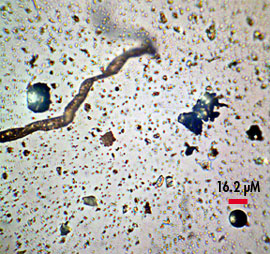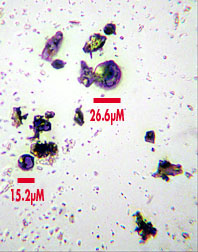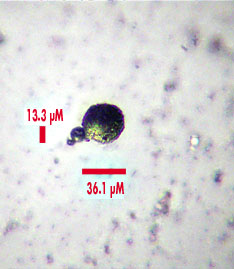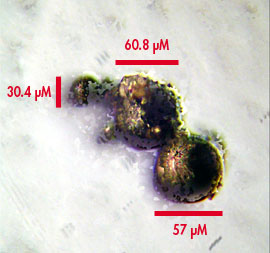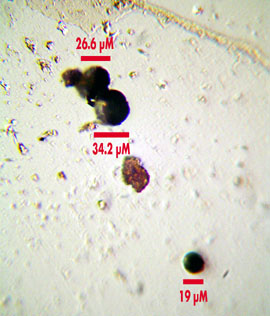Micromets keep 'a fallin' on my head...
Richard Haynes, Missouri
U.S.A.
These micromets are so tiny (~1 X 10-6 g weight), they don't generally fall straight to earth but may be carried by winds aloft for some time before they gradually escape in rain, snow, ice, etc., and come to rest on earth, the majority of them falling into the oceans. Image 1 is typical.
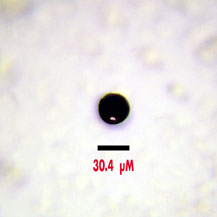
1. A micromet at 40X
For my collecting, I found the roof and guttering system of my house was the best location. Rain and melting snow (possibly containing micromets) scour loose particles (some will be micromets) off the roof and funnel them into the guttering where the water and debris will pool in one or more 8 to 20 liter-size plastic buckets placed at the end of the drain spouts. Following a generous rain, a significant quantity of water along with dirt, wood, leaves, insects and other items will be in the bucket(s). [I use two 20 liter (5 gallon U.S.) buckets at two different spouts.]
At this point the micromets must be separated from the rest of the muck and junk in the bucket. The vital piece of collecting equipment is a strong magnet. I use a 25 mm diameter neodymium disk magnet. These may be found at a number of on-line companies. One such is www.wondermagnet.com. (I have no affliation, financial or otherwise with them.) After carefully decanting the water from the bucket leaving only the watery solids on the bottom, place the magnet into a small plastic bag (sandwich bag) and lower it into the muck. Swirl it several times, then lift the bag and inspect it. Iron rich particles will of course cling to the outside of the bag. Gently wash the outside of the bag under running water to dislodge any non-magnetic, clinging trash.
On a white sheet of paper, lay several clean microscope slides. Now remove the magnet from the inside of the plastic bag. Over the slides, shake the plastic bag to dislodge any particles adhering to it. (If you want all your possible metal particles in the center of a slide, just move your magnet around under it. Careful, however! Approach from the bottom of the slide only.)
Examine your findings with the 4X and 10X objectives. It is most likely you'll see nothing of interest at 4X and possibly not at 10X though large clusters will be seen. The 40X objective will show micromets if any are present. (I employed oblique, top lighting on all these photomicrographs.) The following photos reveal what you may expect to find on your slides. These were sequentially imaged and then combined into a 3D effect with Alan Hadley's marvelous freeware CombineZ4. (An updated version, CZ5, is available at www.hadleyweb.pwp.blueyonder.co.uk.) Such a program really brings a micromet to "life".
